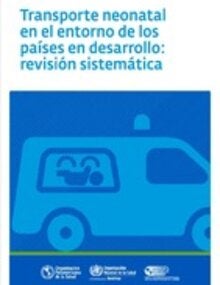Background: Reduction in neonatal mortality is central to achieving global child survival targets in the coming decades. Efforts to prevent the primary causes of neonatal death (prematurity, asphyxia, severe infections, congenital anomalies) must be complemented by development of systems to care for sick newborns, including safe neonatal transport. Objectives: This systematic review identifies and analyzes the evidence on neonatal transport in developing countries in order to highlight important conclusions and gaps in knowledge in preparation for development of clinical guidelines and practical tools to support safe neonatal transport. Methods: The electronic search strategy included terms related to transport, access, and referral of neonates. Data sources included MEDLINE, Embase, CINAHL, Web of Science, the Cochrane Library, LILACS, SciELO, and African Index Medicus. Eligible studies utilized a randomized, quasirandomized or non-randomized prospective design with a comparison group. Cross-sectional, caseseries, case-control, or cohort studies that identified modifiable outcomes were included when there were defined comparison groups or comparison with established standards or guidelines. The review focused on transport of infants with an age 28 days or less from the community or a primary care facility to a center with specialty neonatal care, as well as interfacility patient transfers between two neonatal specialty care centers and intra-facility patient transfers to/from a neonatal specialty care unit. Articles were evaluated for strength of study design, selection bias, control for confounders, and data collection methods. Results: Forty studies met inclusion criteria. There were no randomized controlled trials and five quasi-experimental pre/post studies; most studies were of moderate to weak quality. Fourteen studies examined physiologic stability during transport and identified potentially modifiable risk factors associated with clinical deterioration and mortality or differential outcomes between inborn and outborn (transported) neonates. Six studies compared management of neonatal transports with norms for performance or formal regional guidelines. Six studies examined the effect of team training/composition on knowledge and skills, physiologic indicators of stability, and/or mortality. Three studies reported trails of equipment (transport carriers or incubator). Eleven studies considered the role of neonatal transport in providing access to the health system. Conclusions and implications: Evidence supported the need for establishment of neonatal transport services to provide equitable and widespread access to high-quality care for infants in the first month of life. Improvement in the outcome of transported neonates can be readily achieved by focusing on issues of basic physiological stability. Specific training in patient assessment and management can improve outcome, but must be accompanied by necessary systems changes, including proper equipment, norms, and oversight.
|

